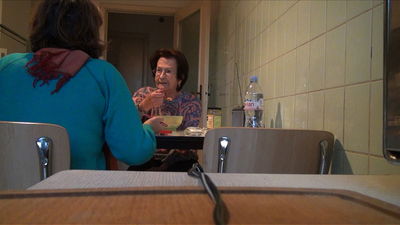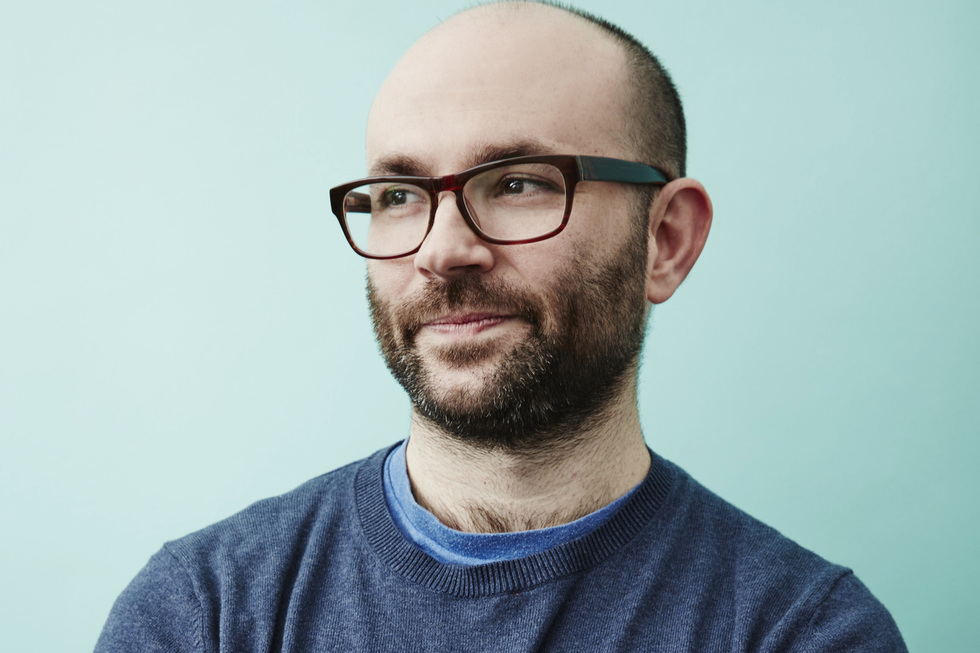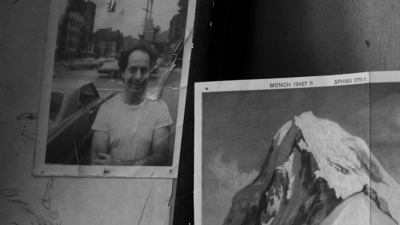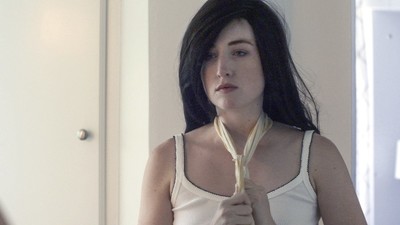
BY MATTHEW ENG |
The Invisible Character: Director Robert Greene Talks KATE PLAYS CHRISTINE
Discussing performance demands, documentary ethics, and Christine Chubbuck with the director of one of 2016's strangest films.

Few films this year are likely to leave more questions than answers in the minds of audiences than Robert Greene’s fascinating and genuinely thought-provoking meta-experiment Kate Plays Christine. In his latest documentary, Greene chronicles actress Kate Lyn Sheil’s frustrated efforts to offer a convincing portrait of Christine Chubbuck, the infamous Florida news anchor who has resided in the whispery, Wiki-searching realm of tabloid pathology since her on-air suicide in 1974. Like Greene’s previous film, Actress, which followed The Wire’s Brandy Burre as she gruelingly attempted to reboot her career, Kate Plays Christine holds steadfast to its genre-bending calculations, allowing us to glimpse the construction of an elaborate, ethically-ambivalent production and then forcing us to watch as it all comes toppling down.
I talked to Greene, who also works as an in-demand independent editor and a professor at the University of Missouri, about the ambitious future of documentary cinema, the early origins of this unusual project, supported by Tribeca Film Institute, and the polarizing, plaintive legacy of its central subject.
When did you first hear about Christine Chubbuck?
It was probably 2004. It was a friend of mine, an artist named Nathan Gelgud, who’s pretty well-known for doing those tote bags of famous directors like Jim Jarmusch and [Jean-Luc] Godard. We went to college and thought about making movies together for many years before he moved on to something else. But he had heard the story and was like, “Hey, have you heard this?” And we were going to make a movie about it. But the feeling I had then and that sort of remained for ten years was that I couldn’t tell that story… The particular details or lack of details of [Chubbuck’s] story meant that the only way to tell a documentary version of it was to pull skeletons out of the closet, which is not something I wanted to do. So that feeling of not being able to do it lasted for a really long time. I would think about the story periodically, sort of never really realizing how I could tell [it]. But that sort of questioning and uncertainty really fueled everything I did in between. And Actress had this layered thing that was happening, where you get some other sort of effect when you put an actor in an observational documentary. And that opened my mind to what we could do.

Why do you find Christine Chubbuck to be such a fascinating figure? Does her story connect with you on a personal level at all?
Suicide has affected everyone who has worked on this film in very serious ways. So that’s an aspect of why we did it. But also, I guess what’s fascinating to me is the deep contradictions in her final act. She came on TV and said I’m going to protest blood and guts television by doing the most blood and guts television thing of all time. And so there’s an anger and a performative quality to that, especially since she wrote her own news story of her attempted suicide — maybe because she felt she was going to live — and left it for the next person to read. There was such an awareness and a fury in what she did that just makes you think of all kinds of things. For me, it makes me think of what she was going through, of being a woman in 1974 in that kind of environment. It makes me think of the relationship between performance and madness. It makes me think of what the politics of what [her act] was and why she felt the need to do it that way.
But the problem is that when you try to look at her life, there are so few narrative clues as to why she might have done it. Some of them are really obvious: Oh, she was lonely so “x.” But also, there are such contradicting stories as to who she was and what she was doing and why she might have done it. Some people thought of her as graceful and funny and some people thought of her as maddeningly obtuse and off-putting. And we just can’t know. If you add it all up together, it doesn’t add up to what she did. And that is fascinating to me because that’s a very human thing. We try desperately to make stories out of suicides because we want to put it away. If we can explain the plot points, so to speak, we can then say, “Okay, it’s something to be put away.” But here — and often — we can’t explain it. And that is all amplified by the fact that she wanted to create this tape. It’s another contradiction. She wanted to create a tape to be seen and yet the tape doesn’t exist. Or, at least, it has never been seen before. And it’s probably the last moment in history that that kind of thing just wouldn’t be on YouTube. A few years later, many people had VCRs. The final, deep irony and tragedy of this situation is that there’s footage of this out there that no one has ever seen. All of that makes me think of the difficulties in trying to tell someone’s story and navigate these tricky ethical and emotional considerations.
At what point did Kate come onboard the project? Was she someone you had immediately considered for the role?
The original concept of Actress was that it was going to be a triptych and Kate was going to be one of the actors that we were following. And Kate and I had been friends since 2005 so we’ve known each other for a really long time. I’ve edited films that she’s been in and we’re friends outside of film. I’d been trying to figure out a way to work with her for a while. So the concept of the movie came with the title. It was always going to be Kate. It had to be Kate. She has a particular way of thinking through things that I find really compelling and her screen presence is unlike anyone else’s. It was kind of obvious that only she could do it. It was only going to be her.
What did you expect from this shoot at the outset? Did you anticipate any of the hostilities and frustrations that ultimately unfolded during the production?
The movie-within-a-movie is designed to be as flat and unconvincing and inadequate as possible. It’s designed to be melodramatic in the way that you’re not going to get a traditional escapist feeling watching it, right? So that was by design. And that required a certain kind of acting that was, you know, for lack of a better word, “bad.” That was something Kate and I talked about at the beginning. But it’s one thing to talk about, it’s another thing to try to do it. It was really difficult because by the time we got to those scenes, which were the last part of the shoot, we had taken on all this water, so to speak, of trying to have a deeper understanding of what we were doing. And Kate, especially, had this feeling of responsibility. So when we arrived at these reenactments, it was really difficult to stick to the concept of the movie.
I guess I expected some tension because we went in knowing that this was going to be tough on all of us and we might not agree about the direction of this thing. But that’s the documentary part of this. We’ve set up this situation where we are going to react [and] that reaction is what we’re documenting, essentially. I anticipated some tension but the distance between Kate and I was something I could not have completely predicted. Of course, I couldn’t have. That’s why I absolutely cling to the idea that this is a documentary. Even if you’re watching Kate and Kate is very aware of what she’s doing for the camera because she’s an actor, it still comes from a place of deep sincerity and real anger because it was a hard process to go through.

What inspired you to select that purposely artificial style as opposed to a more authentic retelling of Christine’s story?
An authentic retelling would undercut the whole thing. [The production is] designed to fail from the beginning. It needed to be cheap and it needed to fail because the failure is central. That’s the concept that we’re watching and reacting to. What I think is unexpected is that there are moments, late in the film, where I do feel like Kate captures Christine on some sort of inexplicable level. And I think that’s the unexpected part. The expected part is that it was going to look cheap and it wasn’t going to “work.” And I wanted it to look like a stage play that’s falling apart as you watch it, in order to make this bigger point about the failure of storytelling. So having an authentic, grounded, realistic kind of style would have undercut that. But having said that, of course, the whole time I thought, Wow, this could totally not work at all. The concept is important to understanding what we’re doing and what Kate is grappling with but the process was fraught with such anxiety and uncertainty and self-loathing. [Laughs] There were plenty of times where I thought, Maybe this is a bad idea. But I’m glad we stuck to it because the film needed to fall apart. That was super important for what we were trying to pull off.
After this and Actress, I’m really curious about what you feel an accomplished performance demands of the performer. Do you feel that acting itself requires some measure of suffering for one’s art?
I don’t think it has to… Kate Plays Christine was painful in a sense, but I think Kate was always in more control than you might perceive onscreen. She knew what she was doing. And I would say the same for Brandi actually. Actors are doing their best when they make us feel they’re on the verge. But the fact is they’re often going to the verge because they want to. That’s their art and that’s their craft. And I think it’s really interesting, in the same way that people read into Christine Chubbuck’s motivation of what she might have been saying when she was going to blow her brains out on television and no one was listening to her, thinking that she was being melodramatic. I think it’s interesting the way we might read into Kate’s performance and not necessarily know how much she is in control or not in control.
I remember having a sort of aversion to theater kids when I was growing up. [Laughs] And [that’s] probably because I didn’t quite understand the craft. After working with Brandi and Kate in the strange way that we made these films, [which were] very different processes requiring a very high level of trust and collaboration between, I just have a really greater respect for the craft of acting. And I don’t think you can compare any performance to what Kate has done in this movie. I think it’s such a layered, complex thing. It’s like its own government conspiracy… I came at it thinking [that] we’re all performing and actors are just hyped versions of what we’re doing all the time. But I left this process thinking that is true, but it’s also more complex. And this also comes from editing films like Queen of Earth and Listen Up Philip and dealing with the level of performance in those films. The give-and-take between the actor and the other side of the camera is always tense and in flux.
One of the most illuminating scenes in the film is the meeting with Steve Newman and Gordon Galbraith, two of Christine’s colleagues, who show Kate the first footage she ever sees of Christine. Later on, one of the coworkers voices some pretty clear skepticism about the motives of the production and whether everyone involved intends to do right by Christine. How formative a moment was this for the film?
That question was what we were questioning as well. And it was great for him to give voice to that. And no one could do that better than Steve, who was her friend. And, in fact, he said no for many inquiries before that. We didn’t think we were ever going to be able to talk to Steve and certainly didn’t know we would be able to talk to Gordon, who was also there and the last person in the room [during the fatal taping]. And that wasn’t something we knew. We knew they were there. They had said no to so many things before that we knew it would be very difficult to talk to them. And it wasn’t until I said, “Look, this is what the movie is actually trying to get at and I’d really appreciate you being honest with us on camera about your whole anxiety about what we’re doing,” that the door unlocked, so to speak, because he felt like it wasn’t going to be cut into something where he was going to be contributing to the exploitation. He was going to have a chance to voice that fear himself.
To me, that’s the nature of this whole movie. That’s the soul of this film: questioning why you would do this in the first place. Having Steve do that… it was just profound. Because he could have said any number of things and he, in a weird way, almost validated our own fears about what we were doing. But we’re still in his house, we’re still with a camera, we’re still editing that. And Kate still says, “Yeah, I know, but…” So you still see that even if we’re in total agreement with him, there’s a big difference between being Steve and carrying around this memory and being someone who took that footage of YouTube because he didn’t feel good about it. There’s a big difference between that guy and the people in the room with the cameras. And I think that’s an important question people should be asking. We can’t let ourselves off the hook. In the end, we’re still making this film. It’s investigating exploitation by diving into exploitation. That’s tricky and I don’t know if it’s positive or not. But I knew that we wanted to get [Steve’s] voice in there, expressing those doubts.

We see you briefly on-camera as Kate’s vexation with the part grows, but you remain largely offscreen for the duration of the film, very much the invisible partner in this central collaboration. Did you ever consider spotlighting your own experience or even moving it on camera at all?
There's a very, very fine line between making yourself the story and having the role of the director be a point of tension with who really matters, which is Kate. And I needed to only be there almost as the villain, urging this thing to happen in the first place. The problem is when you put yourself on camera, you can only do two things: you can caricature or give yourself empathy. And I didn’t want empathy for the role I was taking. And I didn’t think a caricature would help the film. In every documentary, the invisible character is the person holding the camera. And the filmmakers are always characters in documentaries because there’s a sense of the provisional nature of making a documentary film, where someone is holding the camera [and] trying to tell a story. In fiction films, it’s the author who’s the invisible character. In nonfiction, [the director] is more of the attempted author. I feel like the documentary filmmaker is always in the documentary. The only reason why I’m on camera is to accentuate some hint of who [Kate] might be negotiating these decisions with. And the mystery of each scene’s intentionality is crucial to driving you into the psychology of the story so that you might get, through Kate, some understanding of Christine. And if I’m there too much, I’d just distract and then [the film] becomes about a filmmaker. The film’s not about a filmmaker. It’s about these bigger questions.
As your films continue to gain significant critical acclaim and wider audience recognition, especially at major festivals, how is your own filmmaking process or status evolving?
I mean, there’s a big difference between filming with me and [cinematographer] Sean [Price Williams] for three days with my half-sister and getting hundreds of thousands of dollars to go to Florida to make this strange film that we convinced people — mainly just a couple people because most people didn’t want to give us any money — to make. That’s a pretty huge difference. For me, it’s all just ideas. Okay, I have a new idea, let’s try to pull it off. I think it’s fun to keep pushing. You could reach Sundance and then say, “Okay, well, I’m gonna cash in my chips and try to make something that’s a lot easier, mentally.” But I would rather keep pushing the form in any ways that I can. That’s why I do it. That’s why I make movies, to try to express something that I don’t think has necessarily been expressed, even though my films very much come from a tradition of filmmakers I love, like Fassbinder, Chantal Akerman, Frederick Wiseman, and Douglas Sirk and all kinds of different influences I really care about. And Cassavetes, of course.
To me, it’s always the same. I think the ideas are getting bigger, but they could easily not. The next one could be: I’m gonna follow someone for two days through a house. I think, in some ways, things are obviously changing. I’m lucky that there are some people — maybe it’s a small group of people — but there are some people who are anticipating what I want to do next and that’s very exciting. And hopefully I won’t fuck it up. [Laughs]
We seem to be at a very unique juncture in documentary film where more and more nonfiction filmmakers — like yourself, but also Kirsten Johnson, Roberto Minervini, Joshua Oppenheimer, Aleksandr Sokurov, and others — are playing with form, tone, and even realism with some truly radical results. What do you imagine for the future of documentary film?
I think what we’re seeing is that basically cheap technology — which has been around at this level since the mid-nineties, so twenty years — has enabled a whole generation of filmmakers to grow up with the idea that they could just go make a movie. It has basically led us to this place where people are embracing this cinematic brand of nonfiction filmmaking that is full of possibilities. There’s nothing inherently new about that. There have been great movies since the beginning of cinema that have embraced some of these tensions in the form, from Robert Flaherty to Dziga Vertov to John Cassavetes to Godard to Frederick Wiseman. Again and again and again, we have seen great films made in this way of this thinking. Kiarostami comes to mind, Akerman, Peter Watkins. Those films have never been easy to define and they’ve never been easy to support. But what we’re seeing now is that when you can make them relatively for cheap, you can pull it off. And audiences seem to be excited about it. They’re all such different films but what they do is embrace the ambiguities of the form and create cinema.
I do have hope. I think it’s a great time to be making documentaries. Even if you want to make a social issue documentary, you have to respond to some of the more radical things that are happening [in film]. I think if you want to make a radical film, you have to respond to some of the social issues that are happening. There are a ton of bad movies being made but there always have been and there always will be. But I think there are great movies being made every day and every year. And I think it’s a very exciting time to be doing this.
Kate Plays Christine opens in limited release on Wednesday, August 24th at select theaters, including IFC Center.

